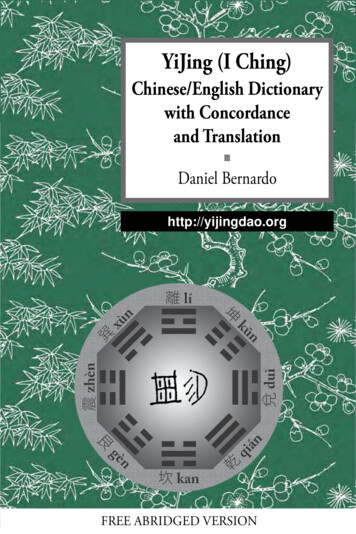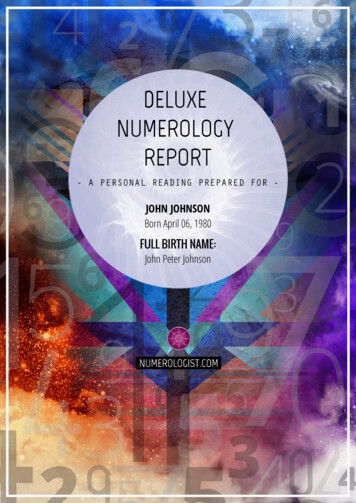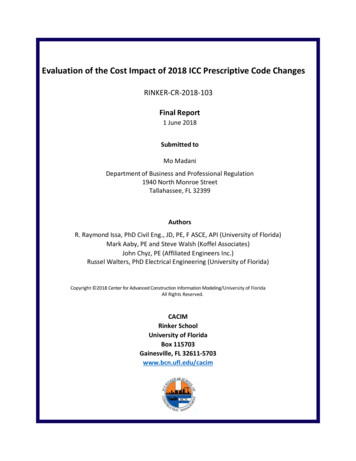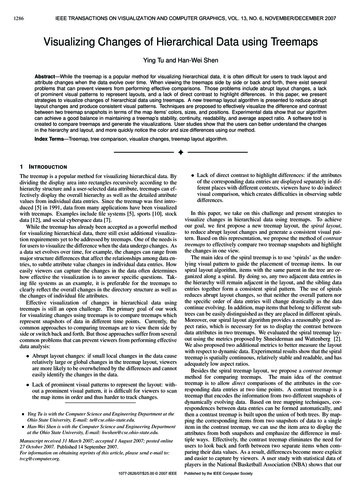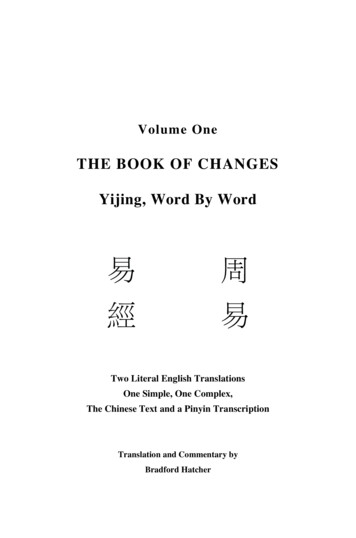
Transcription
Volume OneTHE BOOK OF CHANGESYijing, Word By Word Two Literal English TranslationsOne Simple, One Complex,The Chinese Text and a Pinyin TranscriptionTranslation and Commentary byBradford Hatcher
Copyright 2009, Bradford Hatcher, All Rights Reserved1st Edition, Published in Nucla, CO: Hermetica.info, 2009Find Current Information at http://www.hermetica.infoDDCS 299.51 . BOO V1LCCN PL2464 Z7 . or PL2478 D .ISBN 978-0-9824191-1-3Volume Two, Sold Separately - ISBN 978-0-9824191-2-0
Table of ContentsVolume OneIntroductionThe Seventy-Eight Diagrams (2 4 8 64)PrefaceNotes on this TranslationProblems with AcademiaThe Structure of the DiagramsMethods of DivinationList of AbbreviationsPart One: Translation and CommentaryIntroductory NotesThe Zhouyi and the First Four WingsIn Simple, Literal TranslationWith the Rogue River CommentariesAnd Miscellaneous NotesPart Two: Xiao Gua, The Fourteen Small SymbolsIntroduction to ScalesEr Yao, The Two Changing LinesSi Xiang, The Four EmblemsBa Gua, The Eight TrigramsPart Three: The History of the YijingThe Zhouyi and YijingThe Nature of the YijingThe Dragon’s JourneyA Yijing Chronology, by DynastyAppendix 1: Lessons for the ScholarsThe Blind Men and the ElephantThe Emperor's New ClothesBody Ritual Among the NacerimaThe Daoist FarmerAppendix 2: Humor in the ZhouyiBibliographyIndex 539540541544549550559572-8
Volume TwoPart Four: The DimensionsIntroductionCorrelative ThoughtGua Ming, The Hexagram NamesGua Bian, The Hexagram ChangesGua Xu, The Hexagram SequencesQian Gua, The Inverse PairsPang Tong Gua, The Opposite PairsJiao Gua, The Reverse PairsHu Gua, The Nuclear HexagramsShi Er Di Zhi, The Twelve Earthly BranchesGua Xiang, The Hexagram ImageBan Xiang, The Half-ImagesSan Cai, The Three PowersYao Wei, The Line PositionsYao De, Line CharacterThe Patterns of the Xian TianFigures One through FortyPart Five: The Matrix, A Translator’s ManualIntroductory NotesThe Zhouyi and the First Four WingsIn Matrix TranslationFootnotesPart Six: GlossaryIntroductionWordsPhrasesCharacters Not in the GlossaryMost Common WordsPronouncing Pinyin ChinesePinyin to Wade-Giles ConversionBibliographyIndex 17463464481484486487502-8
The Seventy-Eight Diagram NamesOEr Yao, The Two Lines:Rou, The Flexible; [Yin, Shadow] I Gang, The Firm; [Yang, Light]Si Xiang, The Four Emblems:W Shui, Water; Tai Yin, SixH Jin, Metal; Shao Yin, EightR Mu, Wood; Shao Yang, SevenY Huo, Fire; Tai Yang, Nine0123Ba Gua, The Eight Trigrams:Kun, Accepting; Di, Earth4 Zhen, Arousal; Lei, ThunderGen, Stillness; Shan, Mountain5 Li, Arising; Ming, BrightnessKan, Exposure; Xian, Canyon6 Dui, Satisfaction; Zhe, LakeXun, Adaptation; Feng, Wind7 Qian, Creating; Tian, 42526272829303132Liu Shi Si Gua, The Sixty-Four Hexagrams:Qian, Creating, Chong Gua33 Dun, DistancingKun, Accepting, Chong Gua34 Da Zhuang, Big and StrongZhun (Tun), Rallying35 Jin, ExpansionMeng, Inexperience36 Ming Yi, Brightness ObscuredXu, Anticipation37 Jia Ren, Family MembersSong, Contention38 Kui, EstrangementShi, The Militia39 Jian, ImpasseBi, Belonging40 Jie, ReleaseXiao Chu, Raising Small Beasts41 Sun, DecreasingLu, Respectful Conduct42 Yi, IncreasingTai, Interplay43 Guai, DecisivenessPi, Separating44 Gou, DissipationTong Ren, Fellowship With Others 45 Cui, CollectednessDa You, Big Domain46 Sheng, AdvancementQian, Authenticity47 Kun, ExhaustionYu, Readiness48 Jing, The WellSui, Following49 Ge, Seasonal ChangeGu, Detoxifying50 Ding, The CauldronLin, Taking Charge51 Zhen, Arousal, Chong GuaGuan, Perspective52 Gen, Stillness, Chong GuaShi He, Biting Through53 Jian, Gradual ProgressBi, Adornment54 Gui Mei, Little Sister’s MarriageBo, Decomposing55 Feng, AbundanceFu, Returning56 Lu, The WandererWu Wang, Without Pretense57 Xun (Sun), Adaptation, Chong GuaDa Chu, Raising Great Beasts58 Dui, Satisfaction, Chong GuaYi, Hungry Mouth59 Huan, ScatteringDa Guo, Greatness in Excess60 Jie, BoundariesKan, Exposure, Chong Gua61 Zhong Fu, The Truth WithinLi, Arising, Chong Gua62 Xiao Guo, Smallness in ExcessXian, Reciprocity63 Ji Ji, Already CompleteHeng, Continuity64 Wei Ji, Not Yet Complete
The Seventy-Eight DiagramsOWRHYI0123456700, 0201, 2302. 0803, 2004, 1605, 3506, 4507, 1208, 1509, 5210, 3911, 5312, 6213, 5614, 3115, 3316, 0717, 0418, 2919, 5920, 4021, 6422, 4723, 0624, 4625, 1826, 4827, 5728, 3229, 5030, 2831, 4432, 2433, 2734, 0335, 4236, 5137, 2138, 1739, 2540, 3641, 2242, 6343, 3744, 5545, 3046, 4947, 1348, 1949, 4150, 6051, 6152, 5453, 3854, 5855, 1056, 1157, 2658, 0559, 0960, 3461, 1462, 4363, 01Two different numbering systems are used for the sixty-four larger diagrams.The sequence numbers on the right are the chapter numbers of the book, whichmost readers will use here. This sequence, called the Hou Tian, will require either akey such as this or memory to move from the raw diagram to the number of itschapter. The sequence numbers seen on the left, called the Xian Tian, representthe most useful order, sequence and arrangement of the diagrams. These are thediagrams as the binary numbers from zero to sixty-three and no key is needed.
IntroductionThe Seventy-Eight Diagrams (2 4 8 64)PrefaceNotes on this TranslationProblems with AcademiaThe Structure of the DiagramsMethods of DivinationList of Abbreviations
PrefaceWelcome to the world's oldest unsolved Chinese puzzle. By the time youare done here it will still be unsolved. This little Book of Changes, which in itsnative Chinese will fit onto less than forty pages, has been teasing and tormentingscholars for thousands of years, and translators for centuries. Many more than tenthousand lifetimes have been spent in its study. Over the centuries it has beenconsulted more often than the Bible, the Koran or the Vedas, and been read morethan Shakespeare or Homer. And yet it lays down no law. It founds no religion. Ittells no story. So what is this odd, inscrutable little tome all about?The safest thing to say at the beginning is that the Yijing (formerly spelledI Ching) began its career as a divination manual at some time during China's EarlyZhou dynasty, roughly or nearly three thousand years ago. However, without anunderstanding of what is, or was, meant by "divination," particularly of what itmeant to the book's authors and its intended readers, we do not know the book'spurpose. Within this question dwell many competing schools, and this work willattempt to construct yet another. If divination means "predicting the future" thenthe Yijing is nothing more than what the sheep think it is: a fortune telling device.And if divination means simply "uncovering the hidden" then the scope of theYijing can comfortably embrace even depth psychology. We can be fairly certainthat the original text, the Zhouyi or the Changes of Zhou, was not the text ofmetaphysical philosophy that it would later be read and "known" as. However,this is not to say it is not a text of moral or ethical philosophy. Complicatingthings further, the Zhouyi represents an attempt to redefine or reinvent divinationitself, in accord with or integrally to the Zhou dynasty’s "Mandate of Heaven,"the new order of that day, so what little we know of the methods which immediately preceded it cannot be considered an entirely reliable foundation.It is also important to understand that it was drafted at a time when thelanguage, particularly as written, was still forming, moving from mnemonic deviceto a medium for the transmission of culture to future generations, from having theability to evoke recollection of things already known to having the ability toconvey ideas to someone with no experience of the subject matter. Writtenlanguage had evolved from nearly four thousand characters at the time of theShang oracle bones to roughly eight at the time of the founding of the Zhou(estimates here vary widely). We are witnessing written language in a vital andvigorous period of its evolution here. And authors who have the Sovereign's ear,and something much more serious than His feedback, are coining words andintroducing new ideas along with them, or using older words and adding newermeanings with the complicity or the agreement of the remainder of a very smalland intellectually mobile social circle around the throne. It was also written at oneof political history's rare fulcrum points, akin in ways to the "Founding Fathers"period in US history, immediately before the Constitution would become anobstacle to the government it created. In other words, it helped to create one ofthose oxymoronic "liberal institutions." It was a day well-seized, even if thechanges were not as sweeping, deep and lasting as the book's authors might have1
liked. They at least got their ideas down in a format that allowed them to sendthese ideas through or across long expanses of time.It sounds rather trivially true, but this is the point most often forgotten inthe study of this work: the book did not write itself. It was written by a group ofhuman beings. It is a real rarity to find anyone who even tries to find the authors'point of view, though of course such an attempt would have its pitfalls. Not beinga fan of Derrida, I consider the search for author intent to be a legitimate exercise.Maybe this is the bottom line: This is a book about what it means to be a humanbeing confronted with choices, especially choices of attitude. And we can alsosay this: what this book lacks in length, it more than makes up for in breadth anddepth. It will expand to fill any room your mind makes for it.Students of the Book of Changes, the I Ching, or the Yijing as it is nowspelled, will at some time be called upon to believe one or more of the followingclaims. All eight of these statements are False:1) At roughly 5000 years of age, the Zhouyi (the oldest layer of the Yijing)is the world's oldest book.2) The Yijing is founded upon a philosophy which describes Change as aproduct of the interaction of the two universal forces known as Yin and Yang.3) The original and primary intent of the Yijing is to divine the future or toforetell one's destiny. Only centuries later did it become a philosophical treatiseand a handbook used to inform ethical behavior.4) The Ten Wings (which, together with the original text, or the Zhouyi ,constitute the Yijing) are a reliable introduction to the thought processes of theoriginal authors and present the dimensions of thought which explain the originof the words of the text and its prognostications.5) Modern academic scholars, armed with a formidable array of tools fromsuch scientific methods as archaeology, etymology and context criticism, are becoming grounded in an unprecedented degree of certainty and are now well ontheir way to a new and more enlightened understanding of what the originalauthors were actually writing about.6) No evidence exists to support the existence of the Ba Gua or Trigramsat the time the original Zhouyi was written. These did not come into being untilthe Spring and Autumn period of the Eastern Zhou, centuries later.7) The key to understanding the Yijing lies in the comprehension of itsgraphic forms and their geometrical and numerical interrelationships. The wordsof the text are merely derived from these formal elements.8) The key to understanding the Yijing lies in the comprehension of itswords, their meanings, and the social and moral principles which it describes. Thegraphics are primarily a way of organizing and filing these thoughts.2
Notes on this TranslationSpeculationWith that said, this book also contains a great deal of conjecture. For morethan 2500 years the great bulk of material written in various schools of thoughton the Book of Changes has been retroactive conjecture, offered as if known asfact, and our modern scholarship is no exception to this. Anyone who claims tobe close to certainty in their interpretation is either deluded or else trying to foolyou. It is too late for perfect understanding - the time is long past for certainty.And barring an archaeological miracle several orders of magnitude greater thanwhat the twentieth century produced, there has been far too much water goneflowing down the Yangtze to ever get upstream and recover what went on in theminds of the Zhouyi authors. We must live with speculation, learn to be honestabout it and work to become more effective in this uncertain state. Further, evenallowing that errors both seen and unseen have persisted for millenia, we cannotsimply toss out the received tradition or the received text and start over. But wecan at least attempt to filter out some of the various intrusions of Confucian,Daoist and other doctrines and correct the more conspicuous and egregiouserrors added to the Zhouyi in the Ten Wings and in the Apocrypha.A number of modern western academic scholars, following the 60 year leadof Chinese academic counterparts, have been developing and peddling a notionthat it is possible to build a solid edifice of Zhouyi interpretation without recourseto speculation. But in fact they are speculating instead on the viability of an arrayof deeply flawed methodologies. In restricting themselves with great rigor to onlythe materials which they permit themselves to use, they are in effect running theirrace on their certain ground fully hobbled, quite often with comical results. Thesescholars call themselves "modernists" (see the Chronology at the end of History,for names & dates). You can recognize them by their translations, which arepopulated by such bizarre entities and activities as: dancing elephants, gruntinghamsters, ripping rats, bunched fat meats, feigning birds, rewarded piglets, primaryreceipts, split open steppers, gullied dragons, cleaved shins, controlled keenings,bodiless men of metal, flayed ewe kneecaps, scooped out jaws, seeking dodders,constant catches, hopping goats, spurting livers, ungauged junctures, choppedout loins, lost money axes and, above all, twitching and tittering captiveseverywhere. These people are sure that this is how the Early Zhou Chinese usedto think and talk. And because they are able to praise each other as experts, andprovide impressive looking sets of footnotes from their cohorts to fall back upon,they are almost getting away with it. The comical aspect has a downside though resources are being diverted from more useful pursuits. These scholars could bedoing filing or something.Even writers who dismiss these modernist interpretations as irrelevant towhat the Zhouyi was (shortly) to become, or simply as someone else's tea, are nowqualifying their dismissals by acknowledging that these unusual interpretationswere indeed the very meanings intended by the original Zhouyi authors when thebook was first compiled. They don't even say "some" of the meanings. And they3
are still acknowledging as valid and true the many faulty premises upon whichthe modernist views are based. And so, perhaps whenever they can, they will givelip service to these ideas by writing off or censoring an ethical or philosophicalgloss as an anachronism. But according to what other rule or assumption arenone of these ethical or philosophical glosses to be found in the original? In fact,while all of the premises of the modernists have been presented as establishedfact, not one of them has ever even been seriously or adequately questioned.There is a broad spectrum of hypotheses and stands to take between wideand narrow latitude, from pure speculation, through various levels of assumptionsabout the received tradition, to these narrow and rigorous attempts at academicexpertise. I eventually had to come to a decision about admitting that I would bespeculating instead of claiming certainty at the level of one of these experts. Sohere is that confession: I am not one of these experts. I make no claim to being anacademic scholar. I am somewhat thankful that they exist, because they have infact made a lot of useful discoveries, and I even have some respect left for some ofthem, but I would be most embarrassed to be one. Their methodologies are soflawed in so many ways that I will shortly use a point by point critique of them asa springboard to describing my own approach. But just in case you are starting toworry that I am going to channel material from our alien masters on Tau CetiPrime, do not be concerned. I intend to hold all of my interpretations accountableand use an objective template to review the consequences of my hypotheses.This, as simply as I can put it, is the template: a) if the translation makes no senseat all, it is wrong, b) every word must make sense in each context in which itoccurs and c) the fiddling with the glosses (translation options for each word)stops when a minimum of assumptions yields a maximum of meaning and sense.DivinationIt is in part due to an accident of ancient technology that we have come tosee the twin religious activities of divination and sacrifice as the central foci ofearly Chinese civilization. These were among the few activities which absolutelyrequired recordation on materials durable enough to survive burial to the presentday. We do know enough to say with confidence that divination and sacrificewere vital aspects of the culture, and that they both justified the political systemand held it together. Ritual functions were a significant part of the sovereign'sjob. But to hear the scholars discourse in their field of expertise, the sovereignand his nobles had time for, and thought of, very little else. In their minds thissubject even closes back in on itself so that the primary function of the Yijing isto assist in divinations about sacrifice. Not once will they make mention of suchother minor matters of state as the proper education and training of the heirs topolitical power.Some of the dictionaries on divination:Webster's: 1) The practice of determining the hidden significance or cause ofevents, sometimes foretelling the future, by various natural, psychological, and4
other techniques. 2. An indication of what is future or secret; augury omen;conjectural presage; prediction.American Heritage : 1. The art or act of foretelling future events or revealingoccult knowledge by means of augury or an alleged supernatural agency. 2. Aninspired guess or presentiment. 3. Something that has been divined.Encyclopedic Theosophical Glossary: The art of obtaining hidden knowledgeby the aid of . spiritual beings . . Often it is a means of utilizing one's own innerfaculties, whether by natural or induced clairvoyance, or by employing theagencies which regulate events apparently casual such as the fall of the cards, themarks in the sand, the drawing of lots; and this last is related to the subject ofomens . . The universal correspondences in nature, the interrelation of all things,imply that the most apparently casual and trivial events have of necessityconnection with other events, so that the one can be interpreted by means of theother, provided only that the diviner knows the rules and has the insight and skill. . It is evident, however, that the condition and capacities of the diviner play anessential part in the success of the operation.Catholic Encyclopedia: (Oh, why not?) From a theological standpoint divinationsupposes the existence of devils who have great natural powers and who,actuated by jealousy of man and hatred of God, ever seek to lessen His glory andto draw man into perdition, or at least to injure him bodily, mentally, andspiritually. Divination is not, as we have seen, foretelling what comes fromnecessity or what generally happens, or foretelling what God reveals or what canbe discovered by human effort, but it is the usurpation of knowledge of thefuture, i.e. arriving at it by inadequate or improper means. This knowledge is aprerogative of Divinity and so the usurper is said to divine.Who are the Spirits in question? Apparently, by the founding of the Zhouthey are a mix of royal ancestors, cultural heroes and nature deities, all somehowsubordinated in a matrix called Di or Shang Di, which the missionaries are eager totranslate as God, or Lord on High. For Shang Di I have adopted the less theisticphrase "highest divinity," which does not need to imply volition or personality.This in turn, when viewed as the highest order of things, is called Tian or Heaven.This Heaven is not all that transcendent - you can see much of it if you look up atnight. As the Chinese culture moved from the Shang into the Zhou, the powers,activities and functions of the spirits evolved as well. Divination was graduallymoving away from prediction and verification, through the spirits' approval andreprimand, and gradually into guidance by good example and inspiration. Choiceentered the field. Questions gradually moved from 'what will' and 'should we' to'how may' and 'why not.' There even came to be spells: 'we desire that . .' Themode of operation of the spirits and ancestors gradually became inspirational, thesetting of inspiring examples in the living of meritorious lives. This then becamean ethic for the ancestors-to-be who were still alive.The milfoil or yarrow stalk method of divination, for which the Zhouyi waswritten, was developed alongside and not in place of the older methods that usedbone and shell. It may be that from the start its use was not strictly the sort of5
royal prerogative that bone and shell were. Allowing for a somewhat broaderclass of users, such as a gradual expansion into the inner court and the highest ofthe noble households, would go a long way towards explaining the broadersubject matter the Zhouyi seems to try to encompass. In any event, any theory ofauthor intent should address the existence of a much broader scope of subjectmatter than would be the primary focus of the king, whether sacrifice obsessed ornot. The modernists avoid this dilemma by reinserting more specific and restrictedsubject matter wherever they can, and would be happiest if they could refer allsubjects back to Shang oracle bone topics and fence it all within the fields ofdivination and sacrifice. But there are far too many metaphors here, covering tooenormous a range within the broader human life experience. It is this grand scopeof topics that has me suggesting that the book is, in part, also a manual for theeducation and training of "young nobility," which was the original meaning ofthe term Junzi, long before it came to be misunderstood as "the Superior Man."The notion of divination may be analyzed along different axes. The mostcommon, obviously, is the fortune-telling axis or fate vs. free will question, wherethe question in the end becomes: What is the point of living? What is the point ofgaining this knowledge and insight, and practicing wisdom and justice, if youcannot change anything? Or is it really all about the Stoic's learning to acceptFate with more dignity and less anxiety? The paradox inherent in the commonunderstanding of divination is usually ignored in these explanations: Isn't thewhole point to be able to avert the bad pronouncements and to capitalize on thegood ones? And what makes people assume that the authors did not know thiswhen they stared at it on a daily basis?If the method simply provides a road and weather report, this questionremains: How does it respond? I am not going to get anywhere near this inquiry(in fact this whole section is simply about scoping the questions). Divination, asunderstood here, describes the landscape, both the surroundings and what lies ashort way ahead. The axis of orientation is past into future. The prognostication isa map of where you stand, complete with forks in the road, reports of brigands inthe canyon, the time of day and the color of the clouds. If you must make thejourney this may help you adapt. When the situation is vastly bigger than we are,and it is presenting itself in a certain typical pattern, then what can be changedmost handily is our response to it. In this response lies choice. And that is whatthe advice would be about: adopting the optimum attitude and making the rightchoice. In every statement the Yijing makes, its opposite can at least be implied.There is not always a need to discuss both sides of an option. If one approach issaid to be unfortunate then one looks also for clues in the text to the wiser or lessself-destructive approach that is implied here.If the method is, in effect, a set of funhouse mirrors for the subconsciousprojections of the querent, the question then becomes: Why not chicken entrails?Oftentimes any new perspective other than the one you are stuck in is sufficientto help one to see things in a new light. But the Zhouyi offers a wonderful,dizzying array of images to reflect upon, accompanied by a divination text,otherwise referred to as mantic formulae or terminology. These images may be6
akin to those found on Shang oracle bones or they may be images drawn fromthe larger Chinese culture. In the 1920's, beginning with Shchutskii in Russia, thetheory that the Zhouyi had been written in two or more distinct layers began togain an enthusiastic acceptance in the west. In 1933 Waley made a thesis of it:"The Book of Changes is an arbitrary amalgam of two quite separateworks: 1) An omen or 'peasant interpretation' text . and 2) a divination textprobably of later date and certainly of a far more sophisticated nature." (p121)He further divides omen texts into three categories: a) substantive inexplicablesensations and involuntary movements, b) those concerning plants, animals andbirds, and c) those concerning natural phenomena. (p122)Exactly why the Zhouyi authors are thought by the academics to be soincapable of the conscious use of simple metaphors and analogies to depictcommon recognizable patterns of activity in the world is a subject for a latersection. At the moment I only want to question the idea of a layered text. Can wereally assume that there is no real connection between the so-called omen textsand the mantic formulae? I really don't see any evidence of this. I do see evidencethat the text is comprised of elements from two or more sets of vocabulary, setswhich most likely originated in different times and places, but this does not meanthey were set down here in different times and places. If I were writing a textwhich required knowledge of both psychological counseling and astrology, andif I expected my readers to be a little familiar with both, I would mix the two in thesame sentence. And maybe I would even have reasons to enumerate things oradd them together. Does this imply that the text has three historical layers, theoldest dating from the origin of counting? Of course not. I am going to take theunpopular view that the text hangs together in a such meaningful way as tosuggest that it was set down as a whole with a vocabulary which represents asynthesis of terminologies.Naturally some of the images date from earlier centuries, and a significantnumber of them may indeed have begun their long careers as "omen or 'peasantinterpretation' texts." This does not mean that they were assembled as nothingmore than a collection of diviners' omens to remind diviners of things they alreadyknew. They were more plausibly reused here with the addition of newer anddeeper insights which had been gained within the small circle for which the textwas written. The metaphors and analogies depicting recognizable patterns ofactivity in the world are simply integrated with a vocabulary describing theprobable outcomes of those patterns. I see the "divination text" as simply a set ofoft repeated vocabulary elements, the lingo that diviners were expected to utter.These were derived over the centuries from practical divination experience.A simpler expression of this is "images in the [Yijing are used] as metaphorsand analogies which function normatively to indicate a basis for decision as toappropriate action in a given situation" (G. Tung p1) or "to provide a perspectiveon experience which can lead to insight and decision for action." (ibid p60).They simply provide a vehicle for perception, and the key to the utility of thevehicle is its mobility. It is thus, from this perspective, important to avoid definingor construing the meaning of a metaphor or analogy too narrowly.7
The application of the prognostications, of good and bad fortune, etc., tothe likely development or outcome of the metaphor or analogy, as opposed toconsidering the mantic terms to be hard predictions of the future in the real world,is indeed a more mature way of looking at and into the future. The various manticformulae or prognostications pronouncing pitfalls, stress or hard work would notbe pointing directly to problems inhering in the future, but to problems inhering insome of the attitudes and behaviors described by the metaphor or analogy. This isperfectly consistent with an understanding that one's fate is not predetermined.The question becomes: Were the people already that mature three thousand yearsago? Well, a lot of people are still not that mature. So let's ask instead: were a fewof the people, the people at the creative vanguard of their culture, already thatmature three thousand years ago?The existence of multiple layers of meaning in the text is another subjectworth studying. The need for the oracle to speak to different situations, as well asto different people at different stages of their personal evolution, will create aneed for what I will call "vertical ambiguity." This is different from providing anoracle which could "go either way" and simply weasel its way out of questions.The prophet Mohammed is credited with giving the advice: "Speak to each one inaccordance with his degree of understanding." The idea that there are inferior andsuperior levels of personal evolution and understanding might well repulse someequalitarians, but I will adopt it here (as the Yijing adopts it in Gua 59). At
Students of the Book of Changes the, I Ching, or the Yijing as it is now spelled, will at some time be called upon to believe one or more of the following claims. All eight of these statements are False: 1) At rou
